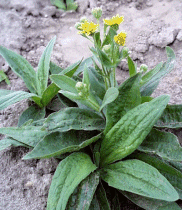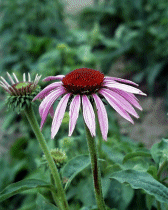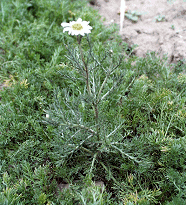
42 Three Island Pond Road, Flatrock, Newfoundland, Canada A1K 1C8 Tel: 709-437-6562





The
Fruit Garden| The Greenhouse
|
The
British Connection| Meet the Herbalist
Workshop
Brochure |The Herb Garden | HOME
|
Garden
Tour | Links
|
Awards
|
These herbs
are grown organically in 4 inch pots.
Selection
varies during the season and is subject to availability.
American Arnica (Arnica chamissonis)
An analysis has indicated that this plant
has the same medicinal action as the European variety, but grows more readily
in alkaline soil.
Agrimony (Agrimonia eupatoria)
Tea made from agrimony has a great reputation
as a wash for healing wounds and skin eruptions. Internally, tea is useful
for liver, kidney and bladder problems. Produces yellow, gold and green
dyes.
Basil, sweet (Ocimum basilicum)
A popular culinary herb.
Bayberry (Myrica pensylvanica)
A native North American plant whose root
bark is used to treat diarrhea and hemorrhage. The wax-covered berries
are used to produce aromatic candles and soap.
Boneset (Eupatorium perfoliatum)
The herb has been used traditionally to
treat fevers and colds, especially for flu.
Burdock (Arctium lappa)
Roots of this common wild plant are said
to have 'blood purifying' properties. Useful for skin diseases, including
eczema. Recent medical evidence supports folkloric use for tumours. One
of the four herbs in the Essiac® anti-cancer formula. Biennial
California Poppy (Eschscholzia californica)
A brightly coloured annual with a mildly
narcotic juice. Useful as a nervine and antispasmodic.
Catnip (Nepeta cataria)
Favourite of cat lovers, for cats relish
the intoxicating leaves. Tea is a popular nightcap, as it induces a good
night's sleep. Remedy for colds and fevers.
Celandine (Chelidonium majus)
Latex juice mixed with vinegar is said
to remove warts and corns. Decoction is useful for stomach pains and inflammation
of the bilary duct.
German Chamomile (Matricari recuitita)
A fresh, apple-like scent comes from the
flowerheads of this annual plant. It is very popular as a tea to aid
indigestion, diarrhea, gastrointestinal disorders and as a skin wash.
Chinese Milk Vetch (Astragulus membranaceus)
A powerful herb to boost the immune system
and increase strength. Lowers blood pressure and blood sugar and
improves circulation.
Calendula (Calendula officinalis)
The orange flower petals are invaluable
in treating skin disorders, used mostly in skins lotions and ointments.
Chives (Allium schoenoprasum)
Mild onion flavoured shoots. Very hardy.
Edible purple flowers can be used in salads for colour and flavour.
Comfrey (Symphytum officinale)
Comfrey is among the most important medicinal
herb. It contains allantoin, a hormone-like substance that stimulates cell
division, making comfrey valuable for healing wounds,ulcers and broken
bones.
Purple, rose or white flowers.
Elecampane (Inula helenium)
Dried root preparations quiets coughing,
stimulates digestion and tones the stomach. Flowers yield yellow and orange
dyes.
Narrowleaf Echinacea (Echinacea augustifolia)
A well known herb that boots the immune
system, used commonly for treating cold and flu symptoms, it's also a great
wound healer.
Echinacea is the International Herb Association's
Herb of the Year for 2002.
Narrowleaf echinacea is medicinally more
active than some other species of echinacea.
Egyptian Onion (Allium x proliferum)
This fascinating mild-flavoured onion
develops bulbs at the top of its slender leaves, not at the base like ordinary
onions. Excellent for pickling and for seasoning soups and stews. They
keep very well in storage.
Evening Primrose (Oenothera biennis)
Oil in the seeds has estrogenic properties
and is used to treat menstrual and menopausal disorders.
Flax, Blue (Linum perenne)
A pretty border plant whose seeds contains
linseed oil. Used to treat rheumatic pains, diarrhea and coughs.
Hops ((Humulus lupulus)
Hops are well known as a flavouring for
beer and act as a sedative. Hops assist in sleeplessness, nervousness
and headache. A poultice of hops combined with other agents will
also reduce inflammation and swelling due to sprains and bruises.
Lady's Mantle ((Alchemilla vulgaris)
Lady's Mantle is an attractive plant with
medicinal use for menstrual disorders, rhumatism and stomach disorders.
Licorice ((Glycyrrhiza glabra)
Licorice is an expectorant and a demulcent,
used medicinally to treat coughs and sore throats. It is 50 times
sweeter than sugar.
Horehound (Marrublum vulgare)
Horehound candies, once the sovereign
remedy for coughs, are still remembered by some. Infusion is useful for
weak stomach, lack of appetite and persistent bronchitis.
Hyssop (Hyssopus officinalis)
Decorative plants with a refreshing aromatic
scent. Slightly bitter leaves are finely chopped on salad, game meats,
soups and stews. Helps digestion. Essential oi used in perfumery.
Lavender (Lavandula augustifolia) 'Hidcote'
For centuries, the fragrant flowers have
been used in dried sachets, scented soaps, perfumes and potpourris. Lavender
oil is an important article of commerce. In the garden, lavender makes
sweet-smelling border plants along pathways. The most popular are the English
varieties.
Lemon Balm (Melissa officinalis)
Fresh leaves burst with lemon when squeezed.
A truly delightful tea made from the dried leaves is a favourite 'anytime'
tea as it both stimulates the heart and calms the nerves. Fresh chopped
leaves re also interesting in salads, soups and stews. Proven effective
against herpes.
Lovage (Levisticum officinale)
Leaves have excellent flavour for soups,
stews and casseroles. Flavour is reminiscent of celery, and of the famous
yeast extract, Maggi. Can replace meat and bone stock in soups. Vigourous
tall growing herb, one of the first to return in spring.
Marshmallow (Althaea officinalis)
Noted for soothing irritations and inflammations
of the skin, throat, eyes, lungs and urinary organs.
Meadowsweet (Filipendula ulmaria)
A beautiful cream flowered perennial herb
that contains salicylic acid, similar chemically to ASA. Used to
treat flue, rheumatism, gout, athritis, fever, etc.
Milk Thistle (Silybum marianum)
One of the most important herbs used in
protecting the liver. A striking annual plant with creamy white leaf
veins.
Mullein (Verbascum thapsus)
Striking yellow flower stalks rise from
a woolly leaf base in the second year. Good remedy for coughs, hoarseness
and bronchitis. All plant parts can be used to produce yellow, bronze and
grey dyes.
Opium Poppy (Papaver somniferum)
The source of opium, morphine and codeine
and is used to control pain. The blue seeds are better known for
their use in baking and do not contain allkoloids.
Parsley(Petroselinum)
Flatleaf and curled parsley are common
in the kitchen. Medicinally, they act as a diuretic, affecting the
urinary system.
Pokeroot (Phytolacca americana)
Pokeroot is used medicinally to treat
disorders of the glandular and lymphatic system. The young leaves
can be eaten, but older leaves are poisonous.
Pennyroyal (Mentha pulegium)
Used in earlier times to flavour puddings
and sauces. Tea is still used today to ease headache. Strong minty aroma.
Has insect repellant properties. Oil is an abortifacient. Not to be
used by pregnant women.
Pleurisy Root (Butterfly Weed) (Ascleplas
tuberosa)
Bright orange-red flowers are worthy of
attention as an ornamental. Roots act specifically on the lungs as an expectorant
and anti-inflammatory. Valuable for all chest complaints, including pleurisy.
Rue (Ruta graveolens)
A bitter herb, used as an emmenagogue.
Can be used sparingly in stews, salads and other dishes. The roots
produce a rose coloured dye.
Sage (Salvia officinalis) Garden
The main culinary variety popular with
onions for pultry stuffing and for flabouring rich meats like pork or duck.
Also in homeade sausage, omelettes, cheese and bean dishes. Sage tea gargle
is valuable for sore throats.
Savory(Satureja) Summer
A strong tasting herb, usually used in
culinary practice, but has the same medicinal activity of thyme and oregano,
acting as an antiseptic and expectorant. There is also some research
indicating it's use as an aphrodisiac.
Scullcap (Scutelleria lateriflora)
An effective, reliable remedy for headache,
neuralgia, insommnia, restlessness, hysteria and convulsions.
St. John's Wort (Hypericum perforatum)
Elixir
Noted for its calming effect for nervous
disorders such as insomnia, depression and bedwetting. The oil is remarkably
soothing and healing when rubbed into painful joints and muscle. Active
constituent is hypericin which is under investigation as a possible treatment
for HIV. Bright yellow flowers yield gold, brown, red and green dyes for
wool.
Soapwort (Saponaria officinalis)
A beautiful low growing plant with pink
flowers. The roots lather like soap when stirred and are used as
a skin wash as well as a mild cleaning agent for delicate or antique fabrics.
Sweet Cicely (Myrrhis odorata)
Sweet, anise-scented leaves that may be
used to flavour desserts, saving about half the sugar. The large
seeds can be used fresh.
Tansy (Tanacetum vulgare 'Crispum')
(Curled Tansy) Finely cut and curled leaves.
Very decorative, excellent landscaping subject. Not as tall or invasive
as the regular variety. Used for dyeing fabric.
Thyme (Thymus vulgaris)
Aromatic, low growing bush or creeping
herb, ideal for rockeries, borders or along pathways. Pretty pink or purple
blossoms are a favourite of honeybees. Culinary and medicinal value. Grow
indoors or out in full sun.
Lemon Thyme, variegated (Thyme x citriodorus
- Aureus)
Strong lemon-scented variety with beautiful
gold margined green leaves that forms a dense mound.
Valerian (Valeriana officinalis) - Anthos
Excellent sedative action. Widely used
to allay pain, nervous unrest, migraine and insomnia. Contains 0.7% essential
oil.
Wormwood (Artemisia absinthium)
Bitter leaves once used in absinthe, vermouth
and other liqueurs. Has great reputation for stimulating the appetite and
improving digestion. One of the oldest known remedies for worms.
Vervain, Blue (Verbena hasta)
A nervine and antispasmotic with a tranquilizing
effect. Useful for insommnia and other nervous conditions.
Yarrow (Achillea millefolium)
Owing to bitter principles, yarrow has
the reputation as a general fortifier, helping build the body's natural
resistance. It improves digestion, circulation and the functions of the
liver, gall bladder and kidneys. Valuable herb for cuts and makes excellent
cosmetic lotions for cleansing and beautifying the skin.
Updated February 27, 2004
The
Fruit Garden| The Greenhouse
|
The
British Connection| Meet the Herbalist
Workshop
Brochure |The Herb Garden | HOME
|
Garden
Tour | Links
|
Awards
|
